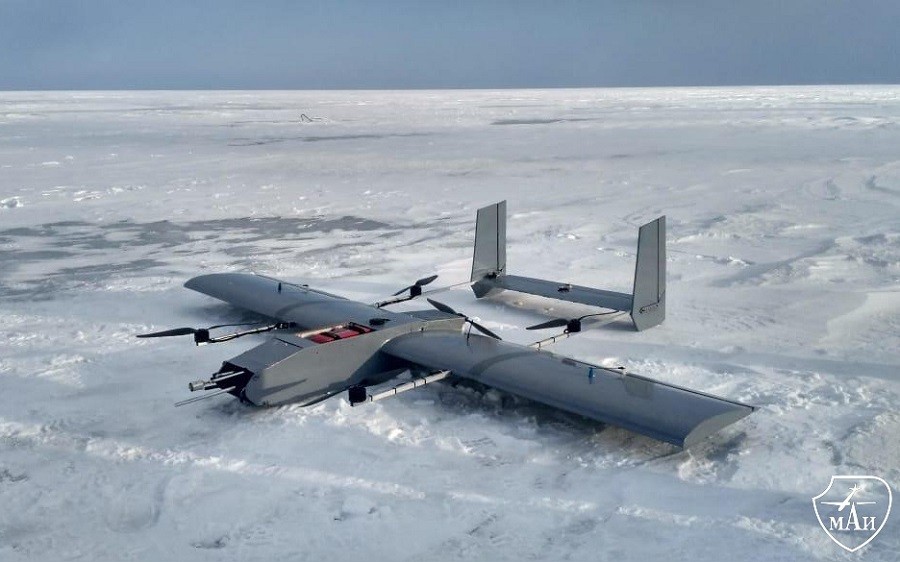
UAV “Tsimlyanin”
UAVs in meteorology
Specialists from the Moscow Aviation Institute and the Obukhov Institute of Atmospheric Physics of the Russian Academy of Sciences have designed the Tsimlyanin unmanned aerial vehicle (UAV), unique for Russia. The device is designed for meteorological research and weather monitoring in the Arctic latitudes. It has now passed flight tests.
The new drone will allow you to explore the turbulent structure of the boundary layer of the atmosphere. In the future, the development can be used to create a network of meteorological monitoring in the Arctic based on UAVs, as well as operational tracking and forecasting of the ice situation along the Northern Sea Route and in the waters of the northern ports of Russia.
Unmanned aerial vehicles have been increasingly used in meteorology in recent years, mainly for research purposes, due to their cost—effectiveness and ease of use. The aerological sounding data obtained from them at different altitudes provide researchers with significantly more complete information than point observations at meteorological stations. In addition, the use of unmanned aerial vehicles allows you to increase the frequency and expand the measurement area.
It is especially important to use drones in remote areas where few meteorological and aerological stations are located at a great distance from each other. This is exactly the problem that exists now in the Arctic: the accuracy of the weather forecast here turns out to be significantly lower than in the middle latitudes.
The growing development of the Arctic requires increasing the reliability of forecasts of such adverse and dangerous weather events as storm surge, wind gustiness, clouds, glaciation, precipitation, etc. An unmanned aerial vehicle of the Tsimlyanin aircraft type was created for this specific task.
Characteristics of the device
The Tsimlyanin was first tested at the landfill of the Obukhov Institute of Atmospheric Physics of the Russian Academy of Sciences in Tsimlyansk — hence its name. It is an unmanned vertical takeoff and landing vehicle, which are carried out like a copter — due to the operation of four lifting screws.
The flight takes place in airplane mode and is provided by the operation of only one pusher propeller. This design of the “Tsimlyanin” was developed by specialists of the competence center “Unmanned aerial vehicles” MAI. The advantage of the hybrid scheme is a soft and controlled take-off and landing mode, which reduces the risk of damage to expensive equipment on board.

The Tsimlyanin does not require special runways, which facilitates its use in Arctic conditions. In addition, with the standard copter scheme, rotating screws create air flow disturbances, which affects the sensor readings. The “hybrid” scheme is practically devoid of this drawback.
The wingspan of the Tsimlyanin is 2.4 m, the payload weight is up to 1.5 kg, the cruising speed is up to 20 m/s, and the flight duration exceeds 60 minutes. The device is equipped with an autopilot and can fly along a predetermined route. Some of the meteorological instruments installed on board are unique and designed specifically for this drone.
In addition to the design of the UAV, the specialists of the Moscow Aviation Institute were responsible for its electronic “stuffing”, which allows receiving, processing and storing information from sensors, transmitting it in real time to ground monitoring points.
Project prospects
Work on the project is being carried out at the expense of a grant from the Russian Science Foundation.
Now researchers are conducting experiments to collect information using a drone and transmit it to ground stations, as well as studying energy exchange over polynyas and streams that form on sea ice fields. In the future, it is planned to develop a mathematical model and software that improve the accuracy of meteorological forecasting in the Arctic.
The next stage is the creation of a pilot meteorological monitoring zone in Arctic conditions using UAVs. It is assumed that the use of such “flying weather stations” will increase the accuracy of forecasting various weather events in the Arctic by 10%, which will increase the safety of both navigation and air travel in the region.
The largest domestic companies operating icebreaking transport, marine surveys, natural gas production, as well as Russian airports, Roshydromet, the Ministry of Emergency Situations and the Ministry of Defense of Russia are interested in such a result.
MAI Press Center Source


